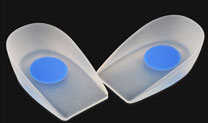Polyurethane materials have excellent physical properties and good processing properties and are widely used in shoe materials.
In the aspect of the insole, the traditional insole adopts the same molding process as the sole, and is directly poured into the insole mold, and the insole has a high density, generally about 300Kg/m3, and has a thicker skin. Although there is better elasticity and comfort, it is basically airtight.
To make a breathable insole, it must be made into polyurethane foam, and be cut, laminated, hot pressed, then finally cut into the finished insole. The newly launched polyurethane
breathable insole combination product meets the requirements of this advanced production process. Under the premise of meeting the basic bearing requirements of the insole, the density is between 100-150kg/m3, the air permeability is excellent, it is hydrolysis resistance, and antibacterial Compared with the EVA insole currently on the market, the polyurethane breathable insole has unparalleled advantages in terms of breathability and compression set.
1, Low density, green and environmental friendly
Low density, saving raw material costs, and using water as the sole blowing agent, environmentally friendly.
2, good ventilation
Through strict material control and fine formula adjustment, the foam structure and air permeability of the foam can be controlled, and the insole made by the hot press forming process can also have good gas permeability.
3, compression resistance
Using the ASTM D395-B-2003 standard, the foam has a compression set value of less than 15%.
4, insole foam production process
It can be either a conventional continuous line foaming process or a batch molding foaming process.


